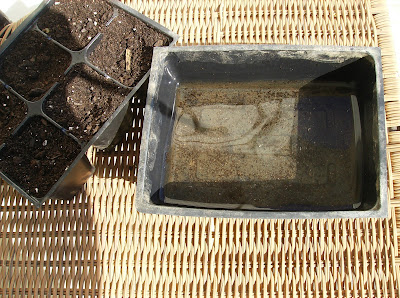Planting Spring Peas:Container Plantings
Coming Soon: Lettuces, Kales, and Other Early Spring Greens
Peas love the cold and can handle the frost. What they don't like is prolonged wet cold soggy soil. It often leads to their death. A bit less dramatically... they mold and don't germinate. I am in Maryland Zone 7 and you can give peas a try, starting in late February if you want to push it. Container plantings can help you do this.
 |
| Planting Container Peas - The Rusted Garden Blog |
The key for peas is to plant them several different ways over many weeks, until you get a batch that sprouts and takes. If you do this in your area, you will get a sense of when the best time is to plant them come the following years of gardening. In my area you can start late February and plant through mid April for best success.
The key for peas is to get them in the ground when the soil isn't frozen and isn't soggy. Some slightly warmer days (50'S) mixed with cold and little rain... brings them to germination. That is hard to predict though. Once they get established they can do their thing. Late winters and early springs are tricky when it comes to weather. A rainy soggy week could knock out most of your peas. That why it is important to plant a patch every week or 10 days until some take. You don't want to be waiting around for them to sprout when they died out.
I recommend planting peas in the later winter and early spring using different methods. The way I most recommend in the early part of the planting season is in 5 gallon containers.
 |
| Container Peas - The Rusted Garden Blog |
Peas fix their own nitrogen and can handle old container soil. But if you have the option, new container soil is the best way to go. Any basic bagged gardening soil will work. Just fill a 5 gallon container with soil and poke drainage holes in the bottom.
The peas should be planted about 1 inch deep and you can plant 5 to 8 peas per container. You can plant two peas to a hole and thin as you see fit. It is a good practice to use 2 seeds in case one doesn't germinate. You can always remove plants. Peas, although they can handle the frost, are fragile and have hollow stems. They need to climb and grow up supports. They break very easily if they don't have something to grab onto and climb. I recommend a tomato cage or several tomato stakes for containers.
The containers help to mitigate the cold sogginess of late winter and early spring. Container peas warm faster and the conditions are better suited for getting those early peas germinating and growing.

Join My Google+ Community Our Tomato and Vegetable Gardens (600+ Members!)
Over 100 HD Garden Videos: Join My YouTube Video Gardening Channel
Follow and Organize The Rusted Garden on Pinterest










